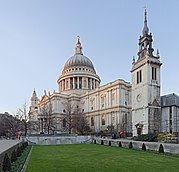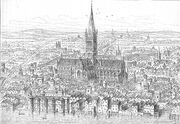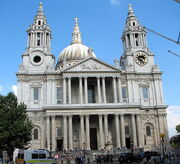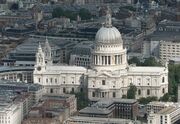
St Paul's Cathedral is the Anglican cathedral on Ludgate Hill, in the City of London, and the seat of the Bishop of London. The present building dates from the 17th century and is generally reckoned to be London's fifth St Paul's Cathedral, although the number is higher if every major medieval reconstruction is counted as a new cathedral. The cathedral sits on the edge of London's oldest region, the City, which originated as a Roman trading post along the edge of the River Thames. The cathedral is one of London's most visited sites.
Previous cathedrals[]
Pre-Norman[]
There had been a late-Roman See in London, but the first Saxon cathedral was built of wood, probably by Mellitus or another of the Augustinian missionaries, on the see's re-foundation in AD 604 on Ludgate Hill in the western part of the old Roman city and the eastern part of Lundenwic. It was these missionaries' habit, as in mainland Europe, to build cathedrals within old Roman city-walls. This building is traditionally said to have been on the site of an ancient megalith, or stone circle, and a temple dedicated to the goddess Diana, in alignment with the Apollo Temple that once stood at Westminster, although Christopher Wren found no evidence of this (Kruger, 1943). This would have only been a modest chapel at first and may well have been destroyed after Mellitus was briefly expelled from the city by Saeberht's pagan successors. It burned down in 675.
The cathedral was rebuilt in stone, in 685. In it was buried King or Saint Sebbi of Essex. It was sacked by the Vikings in 961, as cited in the Anglo-Saxon Chronicle.
The third cathedral was begun in 962, again in stone. In it was buried Ethelred the Unready. It burnt, with the whole city, in a fire in 1087 (Anglo-Saxon Chronicle).
'Old St Paul's'[]

Old St Paul's prior to 1561, with intact spire
The fourth St Paul's (known as Old St Paul's, a 19th-century coinage, or the pre-Great Fire St Paul's) was begun by the Normans after the 1087 fire. Work took over 200 years, and a great deal was lost in a fire in 1136. The roof was once more built of wood, which was ultimately to doom the building. The church was consecrated in 1240, but a change of heart led to the commencement of an enlargement programme in 1256. This 'New Work' was completed in 1314 - the cathedral had been consecrated in 1300. It was the third-longest church in Europe. Excavations in 1878 by Francis Penrose showed it was 585 feet (178 m) long and 100 feet (30 m) wide (290 feet or 87 m across the transepts and crossing), and had one of Europe's tallest spires, at some 489 feet (149 m).
By the 16th century the building was decaying. Under Henry VIII and Edward VI, the Dissolution of the Monasteries and Chantries Acts led to the destruction of interior ornamentation and the cloisters, charnels, crypts, chapels, shrines, chantries and other buildings in the churchyard. Many of these former religious sites in St Paul's Churchyard, having been seized by the crown, were sold as shops and rental properties, especially to printers and booksellers, who were often evangelical Protestants. Buildings that were razed often supplied ready-dressed building material for construction projects, such as the Lord Protector's city palace, Somerset House.
Crowds were drawn to the northeast corner of the Churchyard, St Paul's Cross, where open-air preaching took place. In 1561 the spire was destroyed by lightning and it was not replaced; this event was taken by both Protestants and Catholics as a sign of God's displeasure at the other faction's actions.
England's first classical architect, Sir Inigo Jones, added the cathedral's west front in the 1630s, but there was much defacing mistreatment of the building by Parliamentarian forces during the English Civil War, when the old documents and charters were dispersed and destroyed (Kelly 2004). "Old St Paul's" was gutted in the Great Fire of London of 1666. While it might have been salvageable, albeit with almost complete reconstruction, a decision was taken to build a new cathedral in a modern style instead. Indeed this had been contemplated even before the fire.
Wren's St Paul's[]
Design and construction[]
The task of designing a replacement structure was assigned to Sir Christopher Wren in 1668, along with over 50 other City churches. His first design, for a replacement on the foundations of the old cathedral, was rejected in 1669. The second design, in the shape of a Greek cross (circa 1670-1672), was rejected as too radical, as was a revised design that resulted in the 1:24 scale "Great Model" on display in the crypt of the cathedral.[1] The 'warrant' design was accepted in 1675, and building work began in June. The first stone of the cathedral was laid in 1677 by Thomas Strong, Wren's master stonemason.[2] The 'warrant' design included a small dome with a spire on top, but King Charles II had given Wren permission to make "ornamental" changes to the approved design, and Wren took the liberty to radically rework the design to the current form, including the large central dome and the towers at the west end.
The cathedral was completed on 20 October 1708, Wren's 76th birthday. On Thursday, 2 December 1697, thirty-two years and three months after a spark from Farryner's bakery had caused the Great Fire of London, St Paul's Cathedral came into use: it proved to be well worth the wait. The widower King William III had been scheduled to appear but, uncomfortable in crowds and public displays, had bowed out at the last minute. The crowd of both the great and the small was so big, and their attitude towards William so indifferent, that he was scarcely missed. The Right Reverend Henry Compton, Bishop of London, preached the sermon. It was based on the text of Psalm 122, "I was glad when they said unto me: Let us go into the house of the LORD." The first regular service was held on the following Sunday. The consensus was as with all such works: some loved it ("Without, within, below, above the eye/ Is filled with unrestrained delight."[3]); some hated it ("...There was an air of Popery about the giled capitals, the heavy arches...They were unfamiliar, un-English.."[4]); while most, once their curiosity was satisfied, didn't think about it one way or another.
- Sir Christopher Wren
- Said, "I am going to dine with some men.
- If anyone calls,
- Say I am designing St Paul's."
- A clerihew by Edmund Clerihew Bentley
Artists and craftsmen[]
The construction and decoration of the Cathedral involved many of the foremost artists and craftsmen in England; these were:
- Sir James Thornhill - painted the eight monochrome paintings of the life of St Paul that adorn the interior of the dome.
- Grinling Gibbons - responsible for the woodwork, most notably the choir stalls, and sculpted the pediment of the north transept.
- Jean Tijou - most of the wrought ironwork, including the gates flanking the high altar.
- Bernard Smith - designed and built the organ.
- Caius Gabriel Cibber - sculpted the pediment of the south transept.
- Francis Bird - sculpted the great west pediment showing the conversion of St Paul, plus the seven large sculptures on the west front.
Description[]

Great West Door.

Plan

West end clock tower
The cathedral is built of Portland stone in a late Renaissance style that is England's sober Baroque. Its impressive dome was inspired by St Peter's Basilica in Rome. It rises 365 feet (108 m) to the cross at its summit, making it a famous London landmark. Wren achieved a pleasing appearance by building three domes: the tall outer dome is non-structural but impressive to view, the lower inner dome provides an artistically balanced interior, and between the two is a structural cone that supports the apex structure and the outer dome. Wren was said to have been hauled up to the rafters in a basket during the building of its later stages to inspect progress.
The nave has three small chapels in the two adjoining aisles – All Souls and St Dunstan's in the north aisle and the Chapel of the Order of St Michael and St George in the south aisle. The main space of the cathedral is centred under the Dome; it rises 108.4 metres from the cathedral floor and holds three circular galleries – the internal Whispering Gallery, the external Stone Gallery, and the external Golden Gallery.
The Whispering Gallery runs around the interior of the Dome and is 99 feet (30.2 m) above the cathedral floor. It is reached by 259 steps from ground level. It gets its name because a whisper against its wall at any point is audible to a listener with an ear held to the wall at any other point around the gallery. This works only for whispered speech - normal voiced speech is not focused in this way.
The base of the inner dome is 173 feet (53.4 m) above the floor. The top of the inner dome is about 65 m above the floor, making this the height of the enclosed space. The cathedral is some 574 feet (175 m) in length (including the portico of the Great West Door), of which 223 feet (68 m) is the nave and 167 feet (51 m) is the choir. The width of the nave is 121 feet (37 m) and across the transepts is 246 feet (75 m).[11] The cathedral is thus slightly shorter but somewhat wider than Old St Paul's.
The quire extends to the east of the dome and holds the stalls for the clergy and the choir and the organ. To the north and south of the dome are the transepts of the North Choir and the South Choir.
Details of the towers at the west end (illustration, left) and their dark voids are boldly scaled, in order to read well from the street below and from a distance, for the towers have always stood out in the urban skyline. They are composed of two complementary elements, a central cylinder rising through the tiers in a series of stacked drums, and paired Corinthian columns at the corners, with buttresses above them, which serve to unify the drum shape with the square block plinth containing the clock. The main entablature breaks forward over the paired columns to express both elements, tying them together in a single horizontal band. The cap, like a bell-shaped miniature dome, supports a gilded finial, a pinecone supported on four scrolling angled brackets, the topmost expression of the consistent theme. The north-west tower contains 13 bells hung for change ringing while the south-west contains four, including Great Paul, at 16½ tons[12] - the largest bell in the British Isles, cast in 1881, and Great Tom (the hour bell), recast twice, after being moved from the old Palace of Westminster.
Post-Wren history[]
This cathedral has survived despite being targeted during the Blitz - it was struck by bombs on 10 October 1940 and 17 April 1941. On 12 September 1940 a time-delayed bomb that had struck the cathedral was successfully defused and removed by a Bomb Disposal detachment of Royal Engineers under the command of Temporary Lieutenant Robert Davies. Had this bomb detonated, it would have totally destroyed the Cathedral, as it left a 100-foot (30 m) crater when it was later remotely detonated in a secure location.[13] As a result of this action, Davies was awarded the George Cross, along with Sapper George Cameron Wylie.[14]. On 29 December 1940 the cathedral had another close call when an incendiary bomb became lodged in the lead shell of the dome but fell outwards onto the Stone Gallery and was put out before it could ignite the
Memorials[]

An aerial view of St Pauls
The cathedral has a very substantial crypt, holding over 200 memorials, and serves as both the Order of the British Empire Chapel and the Treasury. The cathedral has very few treasures: many have been lost, and in 1810 a major robbery took almost all of the remaining precious artefacts. Christopher Wren was the first person to be interred, in 1723: on the wall above his tomb in the crypt is written, "Lector, si monumentum requiris, circumspice" (Reader, if you seek his monument, look around you).
St Paul's is home to other plaques, carvings, statues, memorials and tombs of famous British figures including:
- General Sir Isaac Brock
- Sir Edwin Lutyens
- John Donne, whose funeral effigy, portraying him in a shroud, but not his tomb, survives from Old St Paul's.
- Lord Kitchener
- The Duke of Wellington
- Lord Nelson
- Henry Moore
- Sir William Alexander Smith
- Sir Winston Churchill
- T. E. Lawrence, whose bust faces Nelson's sarcophagus
- Sir Alexander Fleming
- Sir Arthur Sullivan
- Florence Nightingale
- J. M. W. Turner
- Sir Joshua Reynolds
- Dr. Samuel Johnson
- Ivor Novello
- Charles Cornwallis
Most of the memorials commemorate the British military, including several lists of servicemen who died in action, the most recent being the Gulf War. There are special monuments to Lord Nelson in the south transept and to the Duke of Wellington in the north aisle; both are buried here. Also remembered are poets, painters, clergy and residents of the local parish. There are lists of the Bishops and cathedral Deans for the last thousand years.
The apse of the cathedral is home to the American Memorial Chapel. It honours American servicemen and women who died in World War II, and was dedicated in 1958. It was paid for entirely by donations from British people, and was designed, as a modern exercise in the Wren style, by Godfrey Allen and Stephen Dykes Bower.[15] The roll of honour contains the names of more than 28,000 Americans who gave their lives while on their way to, or stationed in, the United Kingdom during the Second World War. It is in front of the chapel's altar. The three chapel windows date from 1960; they feature themes of service and sacrifice, while the insignia around the edges represent the American states and the US armed forces. The limewood panelling incorporates a rocket - a tribute to America's achievements in space.[16]
The cathedral has been the site of many famous funerals, including those of Horatio Nelson, the Duke of Wellington, Sir Winston Churchill and George Mallory.
Modern-day[]

St Paul's from across the Thames, over the top of surrounding postwar construction
The Royal Family holds most of their important marriages, christenings and funerals at Westminster Abbey, but St Paul's was used for the marriage of Charles, Prince of Wales and Lady Diana Spencer. The religious service for Queen Victoria's Diamond Jubilee was also celebrated there.
In 2001, Britain's memorial service to honour the victims of the September 11, 2001 attacks was held at the cathedral, attended by the Royal Family and then-U.S. ambassador William Farish. Prince Philip spoke, as did Farish, and Farish said in 2004 in The Times just before he resigned as ambassador that this service showed the strong relationship between the US and Britain. On 1 November 2005 it held a memorial service for the 7 July bombings.
The cathedral is open to the public, with a charge for non-worshipping visitors. It is possible to climb the 530 steps to the golden gallery, where there is a fine view of London. In 2000, the cathedral began a major restoration programme, scheduled for completion in 2008, to celebrate the 300th anniversary of its opening. A ceremony to celebrate the anniversary was directed by Patrick Garland. The restoration programme is expected to cost £40 million, and involves repair and cleaning of the building, and improvement of visitor facilities, such as accessibility for the disabled, and provision of additional educational facilities.
In 2007, the World Monuments Fund and American Express awarded St Paul's a grant as part of their Sustainable Tourism initiative. The project will open up rarely seen areas, relieve crowding in the nave - which suffers heavily from foot traffic and fluctuations in humidity - and fund a new Exploration Centre in the crypt. This centre will provide insight into a variety of topics relating to the cathedral, including architecture, history, science, music, and, of course, religion. A lapidarium of recovered medieval stones and the room containing Wren's "Great Model" (currently only seen by appointment) will also be opened to the public.
Organ and Organists[]
Organ[]
The organ was commissioned in 1694: the current instrument is the third-biggest in Britain with 7,189 pipes and 108 stops, enclosed in an impressive case by Grinling Gibbons.
Details of the organ from the National Pipe Organ Register
Organists and Directors of Music[]
- 1528 Bernad Sibsalem Fembesas
- 1530 John Redford
- 1549 Thomas Giles
- 1591 Thomas Morley
- 1622 John Tomkins
- 1624 Adrian Batten
- 1638 Aibertus Bryne
- 1687 Isaac Blackwell
- 1699 Jeremiah Clarke
- 1707 Richard Brind
- 1718 Maurice Greene
- 1756 John Jones
- 1796 Thomas Attwood
- 1838 John Goss
- 1872 John Stainer
- 1888 George Martin
- 1916 Charles Macpherson
- 1927 Stanley Marchant
- 1936 John Dykes Bower
- 1968 Christopher Dearnley
- 1990 John Scott
- 2004 Malcolm Archer
- 2007 Andrew Carwood
| This page uses Creative Commons Licensed content from Wikipedia (view authors). That Wikipedia page probably contains more information. |